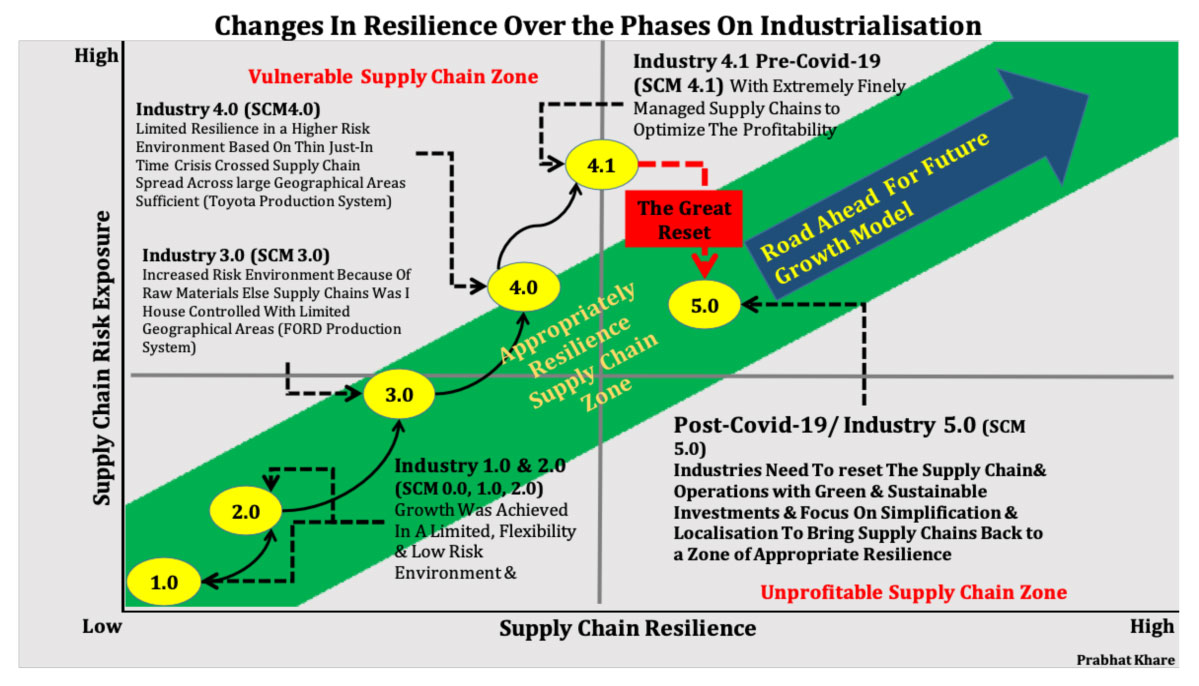Supply Chain and its Management
Historically a supply chain system has always been part of human societies. It has existed in different ages and time by arranging supplies of different goods and services from one area to another or in the same area to meet diverse, growing demands and needs of people or to just earn profits. Despite the fact the present form of supply chain system started when Henry Ford started his “Mass Production” system of automobiles in early 1910 and evolved along with the evolution of the automotive industry, it wasn’t till 1982, when Keith Oliver, a consultant at Booz Allen Hamilton, introduced the term “Supply Chain Management System (SCMS)” to the public domain in an interview for the Financial Times.
The impact of this new wave did not leave SCMS untouched either, resulting in reincarnation of SCMS (Push System) to JIT-SCMS (Pull System). JIT-SCMSM followed the principle of “Lean” providing right supplies at the right place and at the right time, eliminating any kind of “in process fat” or wastages (MUDA) in terms efforts (labor), processing (machine) or storage and handling (method) in the whole supply chain. This was a new fine-tuned supply chain system with almost no “fat” (no excess materials in pipe line, no delay in deliveries, no mismatches/no wrong part supplies/no rework) brought down the cost of manufacturing befitting customers as well as building profits of organizations. The core of this new philosophy was to perfect the timing of ordering, procurement and delivery of all required materials, as and when they were needed at the place of actual use.
Although the JITSCMS took birth in manufacturing industry, its principles were expanded to a wide range of processes for getting competitive advantage. JITSCMS encouraged organizations to develop and implement supply/delivery chains which were as efficient and economical as possible and started covering everything from production to product development to HR to the information systems and many more. With time the JITSCMS became a highly complex network of various flows extending beyond 4Ms (Man, Machine, Material, Method) to 8Ms (adding Management, Milieu, Measurement, and Money). It became trimmer, quicker and faster. And with time, changed into an integrated network of materials and information flow with smarter deliveries involving real time tracking of material flow during its complete supply chain cycle before getting delivered at their final destination.
However, this well-oiled, fine-tuned and smoothly running supply chain machinery was about to get a jolt with an impact so strong that it would shake the whole system to its roots and would force the world to think about newer and alternative ways of managing future SCM.

The Shock, “The Great Reset” and New Learning
And the jolt did come at the end of 2019 in an unexpected form of the coronavirus pandemic (COVID-19) creating havoc of unprecedented nature at a pace and severity not seen in recent history. The social, business and industrial lives across the whole world almost crumbled, bringing many economies to their knees. The fast moving wheel of the global economy had a sudden braking. The impact was more severe in terms of human lives with a loss of about 2.2 million people (WHO as of Jan 2021). The evaluation of COVID-19’s repercussions may take deeper and longer studies but certainly its impacts are expected to be far worse than that of the Global Financial Crisis of 2008-09 or even the Great Depression of the 1930s. Mother Nature seems to have literally pressed the reset button for the mad industrial growth of the world which started from the invention of the steam engine and increased its pace with each passing year.
Considering the scale and severity of the impact of COVID-19 on the whole world, in May 2020, the term “The Great Reset” was very appropriately used by Prince Charles (UK) and WEF director Klaus Schwab for this pandemic, in their proposal to WEF. The paper suggests rebuilding the new global economy by seeking newer ways to improve capitalism in which investments need to be made by focusing more on environmental initiatives. According to Klaus Schwab’s proposal, the new initiative for doing business would not change the economic system, but rather improve it to what he considers to be “Responsible Capitalism”.
Apart from many other impacts on human life, including the way we live and interact socially, “The Great Reset” has exposed the weakest link of the DNA of JITSCMS. The JITSCMS, a system, which proved to be extremely successful in smaller geographical boundaries of Japan and later to some extent in whole world when it expanded its footprint, probably was not really ready for a crisis like the current pandemic. Over the last few decades, in order to improve performances, JITSCMS moved to razor thin functioning, with almost no or minimum contingency margins in the whole supply chain. It seems it has reached its threshold limit and had also become vulnerable while expanding on global level. While expanding across the globe, JITSCMS developed into a network, crisscrossing continents as multi-tier suppliers, could possibly be located anywhere on the planet and was expecting to fall on any minor disruption.
The signals were already coming when between 2002-2004 SARS (Severe acute respiratory syndrome) pandemic broke, when Tsunami struck Thailand in December 2004 and again when Tsunami struck Japan in March 2011. Unfortunately, those were the times when India had opened its market for FDI while China was pumping its economic muscles, growing as new global economic power and hence in that mad growth rush no lessons were learnt.
With time, these JITSCM became extremely large and complex with multi-layered operations and no one ever bothered about what would happen in case any of the weakest links in these chains get broken. And the COVID-19 did the same. It not only broke one but many of the weaker links in JITSCM, for a few months, it almost froze the complete global supply chains. And when the weak links got broken/ frozen, these fine-tuned, trimmed supply chains, spread across the globe, started crumbling like a pack of cards. The businesses could only continue their operations till the last piece of supply feeds existed and then they had to pull the plugs out.
The Future of Supply Chains Post “The Great Reset”
Many questions on JITSCM were already brewing in the inner circles of global supply chain operators as well as many OEMs who were facing the intermittent impacts of regional pandemics, disasters and were concerned about these finely managed operations of complex supply chains. In light of this troubled past, COVID-19 had raised the much bigger question on JITSCM epitomizing what happens to “just-in-time”; “just-in-case” supply gets another disruption of the level of current pandemic.
The businesses worldwide are also discussing a need to reinvent new operational dynamics with newer concepts to take a quantum leap using enabled technologies. We are already familiar with some of these technologies, today, while some may evolve in the future to create newer platforms for the new form of JITSCMS. The technologies like IoT/ IIoT/AI and Machine Learning, Augmented /Virtual Reality/ On Demand Additive Manufacturing/ Voice Activated Technology/ End to End Digital Connectivity/ Big Data/ Cloud Computing/ Drones/ 3D Printing/ Blockchain/ Robotics/ Predictive Analytics and many other could be forming the framework as well as driving the development of future supply chain models.
Before “The Great Reset”, SCM related risk management principles were often only applied to Tier 1 or Tier 2 suppliers, leaving OEMs blindsided and vulnerable to shocks affecting their “invisible” lower-tier supplier chains. However, in reality these lower-tier suppliers have always been more critically important in the overall supply-chain hierarchy. This pandemic also brought a lesson for OEMs that in order to effectively manage their systems; they need to be agile about the information till the last end of supply chain. Such information management of full supply chain would help OEMs to better manage the risks involved in such pandemic.
Building the New Normal and Becoming Future Ready
In order to imagine what the Digital Supply Chain of the future will look like we need to consider and articulate what the underlying philosophies, beliefs, and paradigms will be. Overall, these testing times made the society, adopting to online services and possibly creating a long-term behavioral change in the way people work, shop, consume, seek health services and education, or generally get things done.
At present, both the timeframe and extent of the COVID-19 impact are uncertain, but the ramifications will continue to be felt even after the spread of the virus is contained. For some organizations, the legacy of the COVID-19 outbreak may linger on for a much longer time while some may recover much earlier however no one can afford to have any slackness in understanding their complete supply chains and their vulnerabilities including the sourcing strategies. However, for any SCMS/JITSCMS, the system needs to evolve around some of the following focus areas:
- Keeping Human/People First
- Building A Strong SWOT (Strengths, Weaknesses, Opportunities, Threats) Team
- Defining Segmentation To Prioritize Demand
- Continual Evaluation Of Supply Chain Scenarios
- Leveraging Data To Improve Tracking of Supply Chain
- Defining and Optimizing In Terms Of Environmental Perspective
Supply Chain 5.0 – Early Dawn
It is expected that tomorrow’s supply chains will be a connected, self-orchestrated, self-correcting ecosystems, where information would flow freely from end to end, in both directions, continuously assessing the demand and supply, generating feedback and self-correcting the whole system to meet the customer or market requirements. It will be fully digital and exceptionally flexible, the ecosystems will dynamically adapt, with increased use of decentralized and localized manufacturing, and single-piece customization capabilities that can respond quickly to individual customer demands.
While industry is already moving to its Version 5.0, the Current SCMS 4.0 or JITSCMS 4.0 need to move up to its own Version 5.0, a new avatar to get integrated with Industry 5.0 (Society 5.0) as soon as possible.
And the day is not far off as the companies are already digitalizing their supply chains with increasing transparency and visibility, collecting and analyzing real time data as well as up-skilling the workforce. On the way to this change, they must also protect their assets by prioritizing cyber security and digital privacy.
With “The Great Reset”, the Supply Chain 5.0 may get a much needed boost from an unexpected quarter. Globally, anti-mass production sentiments are a salient feature of the evolving “Society 5.0” and factor into the application of JITSCM 5.0.
Interestingly, like Industry 5.0, Supply Chain 5.0 also will have to rely heavily on collaborative robots (cobots) and need to combine human creativity and ingenuity along with the productivity, speed, and consistency of robots to improve the customer experience. The rise of Society 5.0 may also give that extra push needed by Supply Chain 4.1 at this stage of transformation. While this next generation of supply chain solution is still in the making, deploying Industry 5.0 technology and amalgamating the current learning of COVID-19 period with JITSCM 4.1 will certainly lead to development of a new way of handling future supply chains.
However, the COVID-19 pandemic, like other previous crises, will certainly leave lasting economic scars around the world in the years to come, but hopefully, it will also become the catalyst of a brighter and more sustainable future, thanks to the acceleration of industries’ transformation, resilience, digitalization, consolidation, reconfiguration and green supply chains, productivity enhancements, and invention of new business models.
- By Prabhat Khare, Director, KK Consultants, BE (Electrical), Gold Medalist, IIT Roorkee
Life Member of National Safety Council, BEE Certified Energy Manager, Lead Assessor For ISO 9K, 14K, 45K & 50K
Industry Expert from Tata Motors, Honda Cars & Ashok Leyland, [email protected]


